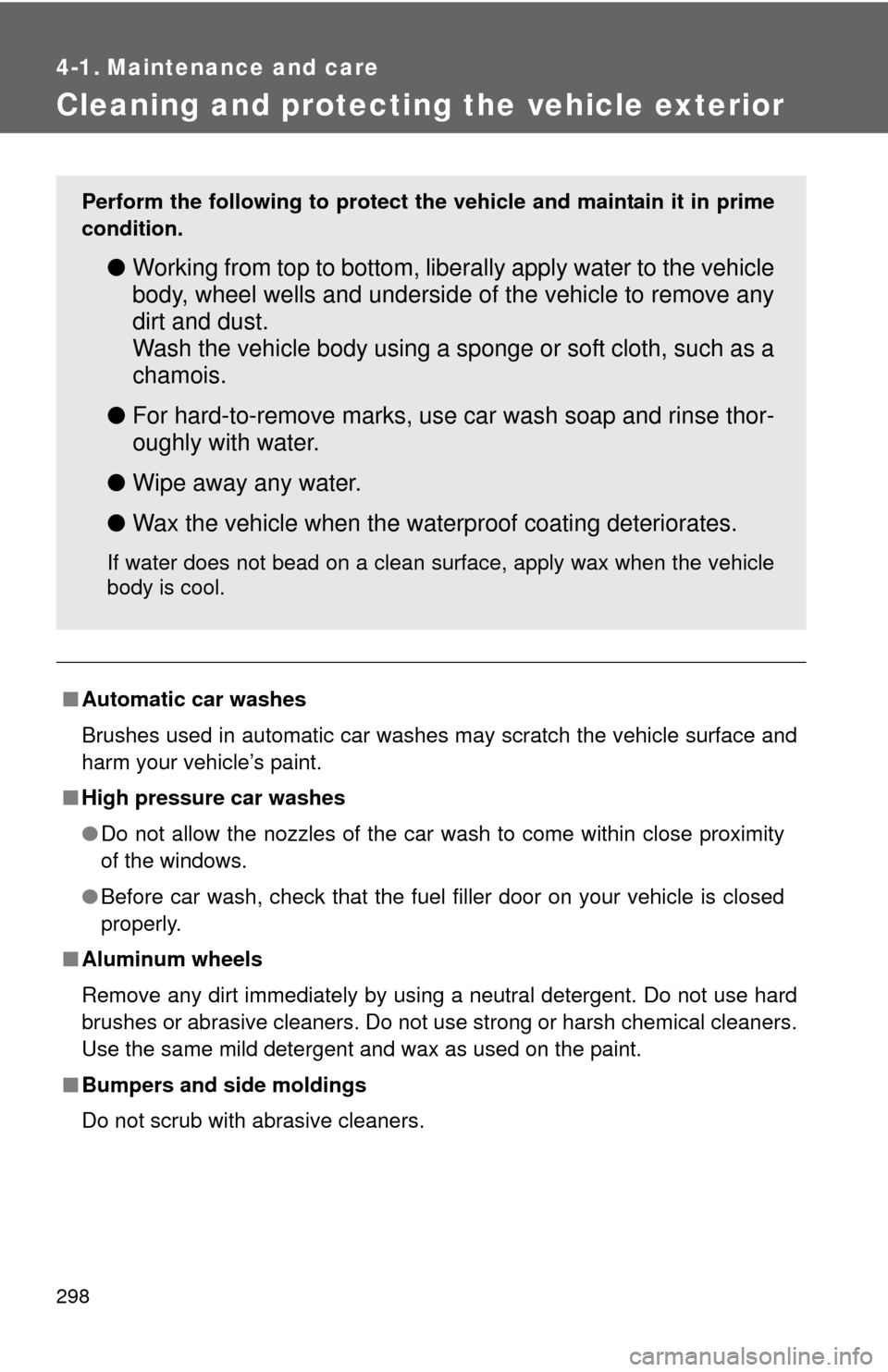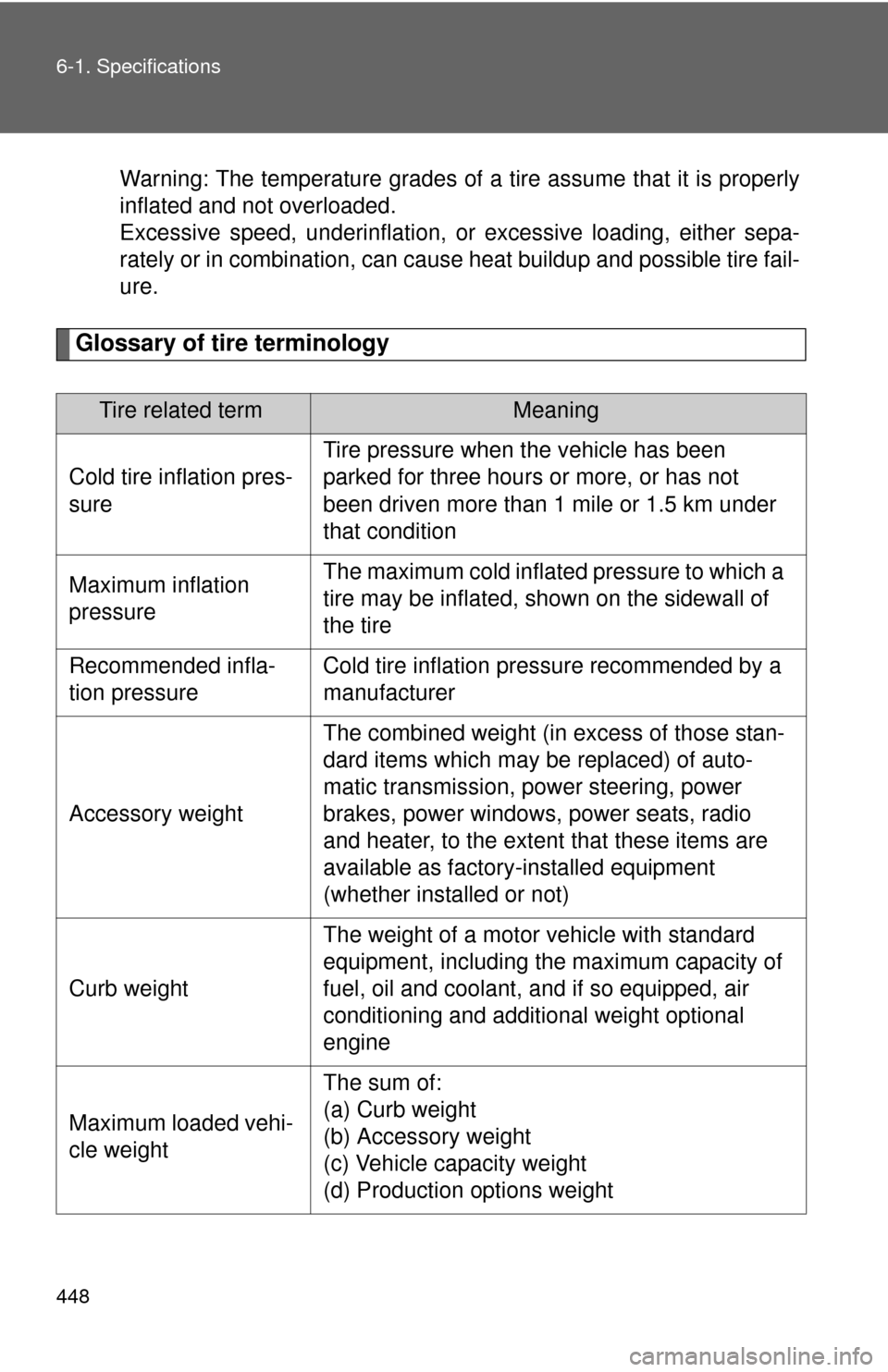Page 7 of 476
7
Tires
●Rotation
● Replacement
● Inflation pressure
● Information
P. 334
P. 400
P. 436
P. 442
Trunk P. 46
Doors P. 41
Fuel filler door P. 73Rear turn signal lights P. 138
Rear window defoggerP. 199
Tail lights P. 152
: If equipped
Tail and rear side marker
lights
P. 152
Page 13 of 476
13
Gauges and meters
Multi-information display
P. 141
P. 149
Tilt and telescopic steering control lever P. 63
Pictorial index
Trunk opener P. 46
Headlight switch
Turn signal lever
Fog light switch
P. 152
P. 138
P. 156
Instrument panel
Audio system
Navigation system *1
P. 201
Windshield wiper and washer switch P. 157
Clock
Security indicator P. 277
P. 77, 79
Outside rear view
mirror switches
P. 66
Tire pressure warning
reset switch
P. 336
Parking brake pedal P. 139
Hood lock release
lever
P. 313
Fuel filler door opener
P. 73
Auxiliary box P. 272: If equipped
*1: Refer to “Navigation System Owner’s Manual”.
Emergency
flasher switch
Page 298 of 476

298
4-1. Maintenance and care
Cleaning and protecting the vehicle exterior
■Automatic car washes
Brushes used in automatic car washes may scratch the vehicle surface and
harm your vehicle’s paint.
■ High pressure car washes
●Do not allow the nozzles of the car wash to come within close proximity
of the windows.
● Before car wash, check that the fuel filler door on your vehicle is closed
properly.
■ Aluminum wheels
Remove any dirt immediately by using a neutral detergent. Do not use har\
d
brushes or abrasive cleaners. Do not use strong or harsh chemical cleaners.
Use the same mild detergent and wax as used on the paint.
■ Bumpers and side moldings
Do not scrub with abrasive cleaners.
Perform the following to protect the vehicle and maintain it in prime
condition.
● Working from top to bottom, liber ally apply water to the vehicle
body, wheel wells and underside of the vehicle to remove any
dirt and dust.
Wash the vehicle body using a sponge or soft cloth, such as a
chamois.
● For hard-to-remove marks, use car wash soap and rinse thor-
oughly with water.
● Wipe away any water.
● Wax the vehicle when the waterproof coating deteriorates.
If water does not bead on a clean surface, apply wax when the vehicle
body is cool.
Page 346 of 476

346 4-3. Do-it-yourself maintenance
■Effects of incorrect tire inflation pressure
Driving with incorrect tire inflation pressure ma y result in the following:
●Reduced fuel efficiency
●Reduced driving comfort and tire life
●Reduced safety
●Damage to the drive train
If a tire needs frequent re filling, have it checked by your Toyota dealer.
■Instructions for checking tire inflation pressure
When checking tire inflation pressure, observe the following:
●Check only when the tires are cold.
If your vehicle has been parked for at least 3 hours and has not been
driven for more than 1 mile or 1.5 km, you will get an accurate cold
tire inflation pressure reading.
●Always use a tire pressure gauge.
The appearance of the tire can be mi sleading. In addition, tire infla-
tion pressures that are even just a few pounds off can degrade ride
and handling.
●Do not bleed or reduce tire inflation pressure after driving. It is normal
for the tire inflation pressure to be higher after driving.
●Never exceed the vehicle capacity weight.
Passengers and luggage weight should be placed so that the vehicle
is balanced.
Page 389 of 476

5
When trouble arises
389
5-2. Steps to take in an emergency
CAUTION
■Maintenance of the tires
Each tire, including the spare (if provided), should be checked monthly
when cold and inflated to the inflation pressure recommended by the
vehicle manufacturer on the vehicle
placard or tire inflation pressure
label (tire and load information label). (If your vehicle has tires of a differ-
ent size than the size indicated on the vehicle placard or tire inflation
pressure label [tire and load information label], you should determine the
proper tire inflation pr essure for those tires.)
As an added safety feature, your vehicle has been equipped with a tire
pressure monitoring system (TPMS-ti re pressure warning system) that
illuminates a low tire pressure telltal e (tire pressure warning light) when
one or more of your tires is significantly under-inflated. Accordingly,
when the low tire pressure telltale (tire pre ssure warning light) illumi-
nates, you should stop and check your tires as soon as possible, and
inflate them to the proper pressure. Driving on a significantly under-
inflated tire causes the tire to overheat and can lead to tire failure.
Under-inflation also reduces fuel effi ciency and tire tread life, and may
affect the vehicle's hand ling and stopping ability.
Please note that the TPMS (tire pressure warning system) is not a sub-
stitute for proper ti re maintenance, an d it is the driver's responsibility to
maintain correct tire pressure, even if under-inflation has not reached the
level to trigger illu mination of the TPMS low ti re pressure telltale (tire
pressure warning light).
Page 448 of 476

448 6-1. Specifications
Warning: The temperature grades of a tire assume that it is properly
inflated and not overloaded.
Excessive speed, underinflation, or excessive loading, either sepa-
rately or in combination, can cause heat buildup and possible tire fail-
ure.
Glossary of tire terminology
Tire related termMeaning
Cold tire inflation pres-
sure Tire pressure when the vehicle has been
parked for three hours or more, or has not
been driven more than 1 mile or 1.5 km under
that condition
Maximum inflation
pressure The maximum cold inflated
pressure to which a
tire may be inflated, s hown on the sidewall of
the tire
Recommended infla-
tion pressure Cold tire inflation pressure recommended by a
manufacturer
Accessory weight The combined weight (in excess of those stan-
dard items which may be replaced) of auto-
matic transmission, power steering, power
brakes, power windows, power seats, radio
and heater, to the extent that these items are
available as factory-installed equipment
(whether installed or not)
Curb weight The weight of a motor vehicle with standard
equipment, including the maximum capacity of
fuel, oil and coolant, and if so equipped, air
conditioning and additional weight optional
engine
Maximum loaded vehi-
cle weight The sum of:
(a) Curb weight
(b) Accessory weight
(c) Vehicle capacity weight
(d) Production options weight
Page 472 of 476

472 Alphabetical index
Vanity lightsVanity lights ........................... 276
Wattage ................................. 438
Vanity mirrors........................... 276
Vehicle identification number ................................... 428
Vehicle stability control........... 162
VSC............................................ 162
Warning buzzers Brake system ........................ 381
Downshifting.......................... 136
Open door ............................. 384
Seat belt reminder ................. 384
Warning lights Anti-lock brake system .......... 382
Brake assist system .............. 382
Brake system ........................ 381
Charging system .... ............... 382
Engine oil maintenance ......... 384
Engine oil pressure ............... 382
Low fuel level ........................ 384
Low tire pressure warning light ..................................... 384
Malfunction indicator lamp .... 382
Master warning light .............. 384
Open door ............................. 384
Pretensioners ........................ 382
Seat belt reminder light ......... 384
SRS airbags .......................... 382
Traction control ..................... 382
Vehicle stability control.......... 382
Washer fluid .......................... 384 Warning messages
Engine coolant
temperature ........................ 392
Engine oil maintenance......... 394
Engine oil pressure ............... 392
Hood ..................................... 394
Moon roof .............................. 394
Open door ............................. 394
Parking brake ........................ 394
Smart key system .. ............... 397
Steering lock ......................... 393
Traction control ..................... 393
Trunk ..................................... 394
Vehicle stability control ......... 393
Washer fluid .......................... 394
Washer Checking ............................... 333
Preparing and checking
before winter ....................... 169
Switch ................................... 157
Washing and waxing ............... 298
Weight Cargo capacity ...................... 165
Load limits ............................. 168
Weight ................................... 428
Wheels ...................................... 348
Window glasses ........................ 68
Window lock switch................... 68
Windows
Power windows ....................... 68
Rear window defogger .......... 199
Washer.................................. 157
Windshield wipers ................... 157
Wireless remote control key Replacing the battery ............ 353
Wireless remote control .......... 37
WMA disc.................................. 217V
W
Page 475 of 476
475
What to do if...
■
Warning lights
P. 384
or
P. 3 8 1P. 384
P. 3 8 2P. 382
P. 3 8 2P. 384
P. 384
or
P. 3 8 2P. 384
P. 3 8 2P. 384
P. 384
or
P. 3 8 2
P. 3 8 4
Brake system warning
lightTire pressure warning
light
Low windshield washer fluid level
warning light
Charging system warn-
ing lightVehicle stability control system and
traction control
system warning light
Low engine oil pressure
warning lightOpen door warning light
Malfunction indicator
lampLow fuel level warning
light
Driver’s seat belt
reminder light
SRS warning lightFront passenger’s seat belt
reminder light
ABS warning lightMaster warning light
Engine oil replacement
reminder light
The warning message is
displayedP. 391If a warning message is displayed